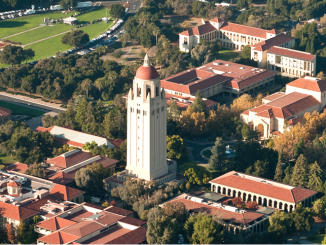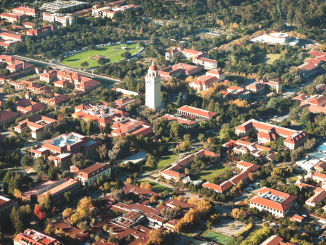
Published in the Daily Post on Feb. 12, 2018. Follow-up story appears below.
BY ELAINE GOODMAN
Daily Post Correspondent
A bill introduced in the California Legislature would ease restrictions on housing projects built near transit — bypassing some of the controls over such development by the cities in which they would be built.
Senate Bill 827, introduced last month by Sen. Scott Wiener, D-San Francisco, would remove density limits and parking requirements for housing built close to transit.
It would also set minimum height limits that cities could impose for such development, ranging from 45 feet to 85 feet in some circumstances. A city could increase that height but not go below it.
SB 827 comes at the same time that the city of Palo Alto is considering an ordinance that would create a new type of zoning to encourage the construction of affordable housing near transit. Under the zoning, called an Affordable Housing Combining District, requirements regarding lot coverage, open space, parking and residential density would be relaxed.
The proposed zoning would apply to projects in which all units are designated affordable. The housing could be built alone or in combination with ground-floor retail. In contrast, Wiener’s bill applies to any housing built near transit, with no requirement for affordability.
SB 827 was introduced on Jan. 3 and has been referred to the Senate committee on transportation and housing.
YIMBYs
According to Wiener’s website, the bill is sponsored by a group called California YIMBY, which stands for “Yes in my backyard.” The name is meant to contrast with NIMBY, a negative term for residents who oppose projects in their neighborhoods, essentially saying “not in my backyard.” California YIM- BY says enough housing hasn’t been built in California to keep up with job and population growth due to “local obstructionism.”
About 125 technology founders, CEOs and investors who are part of the California YIMBY Tech Network signed a letter in support of SB 827.
“The lack of homebuilding in California imperils our ability to hire employees and grow our companies,” the letter states. “We recognize that the housing shortage leads to displacement, crushing rent burdens, long commutes, and environmental harm, and we want to be part of the solution.”
California YIMBY says the housing bill would work in concert with increases in the state’s vehicle and gas taxes approved last year, which are expected to raise more than $800 million a year over 10 years for public transportation.
“SB 827 makes good on that investment by allowing more people to live near transit rich areas,” the organization said.
SB 827 would relax restrictions on housing built within a half mile of a major transit stop or a quarter-mile from a high-quality transit corridor — defined as a corridor with bus service running at least once every 15 minutes during peak commute hours.
No density limits or parking minimums
Wiener’s bill would remove density maximums and parking minimums for such projects, as well as any design standards that would prevent the developer from building the maximum number of units consistent with building code.
And the bill would dictate the minimum height limit a city could impose on projects near transit. The minimum height could go as high as 85 feet — allow- ing a building about eight stories tall — if the project is within a block of a major transit stop or within a quarter mile of a “high-quality” transit corridor, unless it faces a relatively narrow street, 45 feet wide or less. In that case, the minimum height limit would be 55 feet.
For projects within a half mile of a major transit stop but farther than a block away, the minimum height limit would be 55 feet, or 45 feet if the building would face a street that is 45-feet wide or narrower.
City governments oppose the bill
The League of California Cities opposes SB 827, saying it would undermine locally developed general plans (called the Comp Plan in Palo Alto), housing plans and development restrictions. Instead, private for-profit housing developers and transit agencies would determine housing densities, parking requirements, and design review standards for projects near transit stops or corridors, the League said in a model letter it crafted for member cities to send to Wiener.
Cities are already required to zone for housing densities that will allow them to meet housing quotas determined under a Regional Housing Needs
Allocation, the League said. The RNHA is based on a determination of a region’s housing needs by the state’s Department of Housing and Community De- velopment.
And a “high-quality transit corridor” as defined in the bill could be miles away from a bus stop, the League said.
“Additionally, SB 827 would provide developers a means to generate additional profits without any requirement to build affordable housing,” the League’s letter states.
Palo Alto’s proposal
In Palo Alto, the city’s Planning and Transportation Commission is scheduled to discuss on Wednesday (Feb. 14) the proposed Affordable-Housing Combining District zoning for projects with 100% affordable housing.
As now proposed, the zoning would apply to ar- eas that are commercially zoned and are within a half mile of a major transit stop or high-quality transit cor- ridor. According to a map included in a report to the commission, qualifying areas are concentrated downtown, in the California Avenue district and along El Camino Real.
The city wouldn’t automatically rezone those areas. Instead, a property owner or housing developer could request the zoning change.
The new zoning would relax requirements for lot coverage, open space and parking. Instead of using a maximum residential density, projects would face a 50-foot height limit and maximum residential floor area ratio of 2.0. FAR is the ratio of a building’s total usable square footage to the square footage of the lot it sits on.
Under the proposed new zoning, standards for setbacks and daylight plane requirements for buildings next to low-density residential districts would not change.
The new zoning could benefit a project proposed last year by nonprofit Palo Alto Housing, which would include 61 affordable housing units plus 2,412 square feet of ground floor commercial space at 3709 El Camino Real.
———————-
Follow-up story published Feb. 14, 2018, in the Daily Post
City comes out swinging against SB827
BY ALLISON LEVITSKY
Daily Post Staff Writer
A new state Senate bill designed to encourage housing near transit by eliminating local laws regulating height, size and parking yesterday drew sharp criticism from Palo Alto officials.
Mayor Liz Kniss sent a letter yesterday (Feb. 13) to Sen. Scott Wiener, D-San Francisco, opposing the bill on the grounds that it could erode support for building housing, undermining local efforts to combat the housing crisis.
As the Post reported on Monday, Senate Bill 827 would increase zoning densities and building heights around major transit stops.
It would also remove parking requirements for housing near transit. It would set minimum height limits that cities could impose for housing near transit, ranging from 45 feet to 85 feet in some circumstances. Palo Alto’s height limit is generally 50 feet.
SB 827 would diminish cities’ ability to make their own rules about how much housing can be built on a given plot of land, or how tall buildings are allowed to be.
Kniss said the city remained committed to improving options for affordable housing, but that the city needed more time to adjust to changes from other Senate bills passed last year that increased densities.
Those bills provided funding and other measures to increase development of vacant or underused parcels of land, something planners call infill develop- ment. The bills also called for looser regulation of granny units.
“We urge a more collaborative approach that builds on past efforts once we fully understand their effectiveness,” Kniss wrote.
The League of California Cities, which represents city governments across the state, has also come out against the bill.
The bill comes at the same time that Palo Alto looks at new approaches for zoning to encourage the construction of affordable housing near transit.
The city is currently looking at an ordinance that would create a new type of zoning called an Afford- able Housing Combining District, relaxing require- ments for lot coverage, open space, parking and residential density.




This is insane. Why even have local government if decisions like the height and parking are taken out of a city’s hands?
Some developers are going to make some big bucks if this goes through. Bet Weiner is backed by the real estate biz.
Are our firetrucks even able to reach the top floor of an 8th-storey building? That’s an example of a local concern that a planning commission and city council would consider before permitting a building that tall. If this bill passes, local decision-making will end. Bad legislation.
Palo Alto City Hall is 10 stories tall, and it is not the tallest building in the city.
I believe there are a few building in NYC, Chicago, San Francisco and a few other cities where they have demonstrated that it’s possible.
Here are a list of the tallest buildings in Palo Alto: https://www.emporis.com/statistics/tallest-buildings/city/101892/palo-alto-ca-usa
As you can see, a number of these buildings are already taller than 85 feet, and most are indeed near El Camino. Most were built many decades ago. In the ensuing period, development has stalled out as local multi-millionaire retirees have conspired to keep “their” town of Palo Alto undersized. Now, young people and local workers like myself are suffering as living costs skyrocket. As it turns out, not everyone benefits from $3 million homes and $3,000+ rents.
The city government has failed so tremendously and absolutely that the state is entirely justified in taking radical action to clean up their mess.
There’s an irony in a city that so vocally prides itself in being progressive and speaks about the value of keeping our borders open to immigrants and refugees blocking actions that would actually allow those immigrants to live in their communities. Additional housing would ease housing prices, allowing folks not in the 1% to actually move in and contribute to the community. It’s incredibly hypocritical to pay lip service to diversity and inclusion, such as protesting Trump’s wall and Muslim Ban, while simultaneously enacting local policies that have the exact same effect on the demographics of the local population.
Modern zoning laws are an outcrop of the 1960’s and 1970’s white flight from urban centers, designed to make it difficult (read: “discretionary review” and similar) for black families to build and settle in these suburban neighborhoods. Now, existing homeowners grasp at straws to protect their financial interest, defending policies that were incredibly racist at their conception by using arguments that make little to no sense (Kurt, a commenter above, lives in a universe where there are no firetrucks capable of serving tall buildings!).
Palo Alto is less than 2% black. Looks like Jim Crow inspired laws are still working away in the heart of Silicon Valley.
My heart goes out to all those poor millionaires who will have to look at all these tall buildings going by as their UberBlack whisks them to their VC firms. My thoughts and prayers are with them, the real victims of the housing crisis.